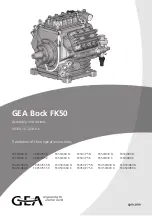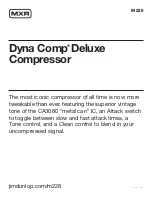
18
The compressor is equipped with two stage air end ("of dry-type") without oil injection into the
compression chamber with the bearings and gearing and the coat of the high pressure part are
lubricated and cooled with oil.
POWER AND CONTROL
The compressor (screw air-end) is driven by an electric motor through a flexible coupling .
Control of the entire electrical system is placed in a electrical box.
AIR CIRCULATION
The air is sucked through the air filter (1) and the suction controller (2) to the air end’s first stage
(3). The compressor suction regulator is equipped with a second stage discharge valve (11) and a
noise damper (12). After compression to the overpressure of up to 0,35 MPa the air is forced from
the 1st stage to the intercooler (5). After cooling in the cooler, the air flows through the cyclone
separator (6) and is sucked to the second stage (7). First stage compression and internal system
are protected against pressure rise above the permissible value by a safety valve (28). After
compression, it reaches an overpressure of up to nominal value and is forced into the end cooler
(9), and then through the check valve (10) to the compressor outlet.
OIL SYSTEM
The oil is sucked by the pump (15) from the oil tank (14) and is forced to the oil filter (19) set
fitted with a thermostat (16) which, depending on the oil temperature, directs the oil directly
through the oil filter (19) to the overflow valve (20) and manifold (21) or at temperature
exceeding 55 ° C to the oil cooler (18) and then through oil filter (19) to the manifold (21). The
pressure in the manifold is limited to 0.14-0.16 MPa with an overflow valve (20). The outlets from
the oil filter assembly to the oil cooler and inlet from the radiator to the unit are equipped with
electromagnetic shut off valves (17) and (17) which are closed (normally closed NZ) when in the
de-energized condition. These valves are designed to prevent the flow of oil from the radiator to
the installation and further to the oil tank, which avoids the need to always fill the radiator with
oil after the compressor's standstill. In addition, the oil level display in the sight glass (13) is
always reliable (without shut off valves the sight glass would be completely filled with oil)
overflow valve (20) in which the oil overpressure is limited to 0.25-0.30 MPa.
From the manifold the oil is distributed to both compression stages ie bearings, seals and coats of
I-stage and II- stage. After passing through the compressor, the oil flows to its tank (14).
After the filter, the oil is also fed to the three-way valve (24) and, depending on the compressor
load, flows to the hydraulic cylinder (23) controlling the shutter (11) in the suction controller (2).
In the second position, the oil from the valve (24) flows to the compressor tank (14). Also the oil
from the hydraulic cylinder is directed to the compressor tank.
















































